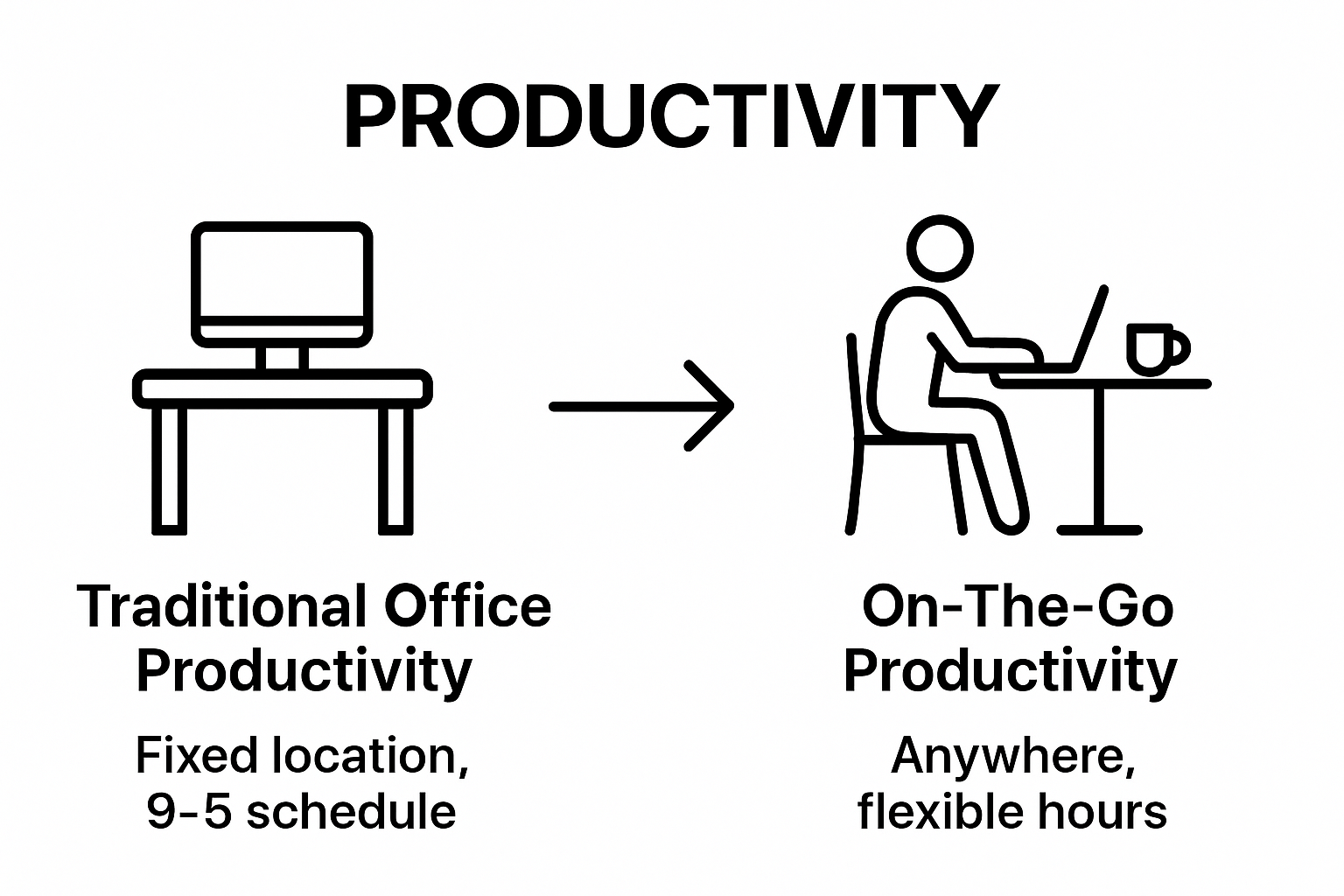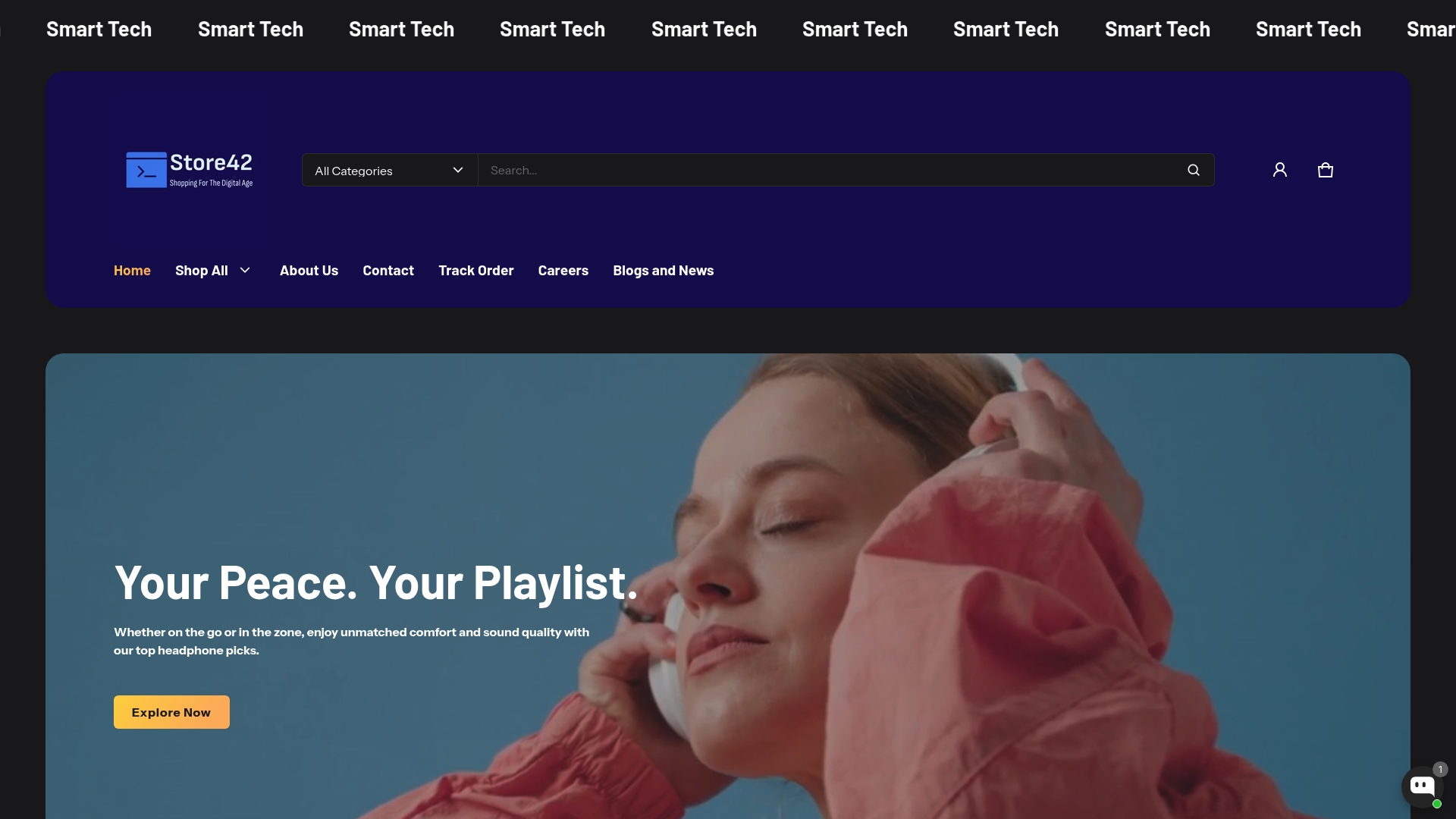Millions of people now work from airports, coffee shops, and park benches. One study from Harvard found that employees with flexible work arrangements are achieving remarkable productivity gains. You might think being away from a desk means getting less done. But the truth is, optimizing productivity on the go can actually outperform classic office routines if you know which strategies make it all click.
Table of Contents
- What Does It Mean To Optimize Productivity On The Go?
- Why Optimizing Productivity Matters In Today’s World
- Key Concepts Behind Productivity Optimization Techniques
- How Technology Enhances Productivity For Remote Workers
- Practical Applications For Boosting Productivity On The Move
Quick Summary
| Takeaway | Explanation |
|---|---|
| Create an adaptable workflow | Focus on developing a flexible system that maximizes productivity regardless of your environment. |
| Leverage technology for productivity | Use cloud services and collaboration tools to enhance efficiency in remote work settings. |
| Minimize digital distractions | Implement strategies like app blocking and notification management to maintain focus during mobile work. |
| Develop personal performance systems | Design customized workflows that reflect your work patterns and adapt to changing circumstances. |
| Understand psychological principles | Align tasks with your natural cognitive rhythms to work smarter, not harder, for optimal productivity. |
What Does It Mean to Optimize Productivity on the Go?
Optimizing productivity on the go involves strategically managing your time, energy, and resources while maintaining mobility and flexibility. It goes beyond traditional work models by transforming how professionals accomplish tasks across different environments and scenarios. Understanding the digital nomad workflow reveals the complex dynamics of modern mobile productivity.
The Core Philosophy of Mobile Productivity
At its essence, optimizing productivity on the go means creating an adaptable workflow that transcends physical workspace limitations. This approach recognizes that productivity is not about being confined to a single location but about maximizing output regardless of your current environment.
 According to Stanford University’s Student Learning Programs, effective mobile productivity requires deliberate strategies to maintain focus and efficiency.
According to Stanford University’s Student Learning Programs, effective mobile productivity requires deliberate strategies to maintain focus and efficiency.
Key characteristics of optimized mobile productivity include:
Below is a table summarizing the key characteristics of optimized mobile productivity, helping readers quickly compare and understand the essential features discussed.
| Characteristic | Description |
|---|---|
| Seamless technology integration | Use of smart devices and platforms for efficient work across locations |
| Robust digital communication tools | Tools enabling clear, instant online collaboration and messaging |
| Flexible work management systems | Workflow setups that adapt to various environments and changing needs |
| Strategic time allocation | Planning and utilizing time blocks for focused work on the move |
| Minimal physical infrastructure dependency | Capability to work efficiently without relying on physical office setups |
- Seamless technology integration
- Robust digital communication tools
- Flexible work management systems
- Strategic time allocation
- Minimal physical infrastructure dependency
Technology and Personal Systems as Productivity Enablers
Modern mobile productivity relies heavily on technological solutions and personal workflow management. Smart devices, cloud computing, and collaborative platforms have revolutionized how professionals work across different settings. The goal is not just completing tasks but doing so with maximum efficiency and minimal friction.
Successful mobile productivity practitioners understand that optimization requires a holistic approach. This means investing in portable technology, developing strong digital communication skills, and creating personal systems that support continuous performance regardless of physical location. Your workflow becomes a dynamic, portable ecosystem that adapts to changing circumstances while maintaining consistent output quality.
Why Optimizing Productivity Matters in Today’s World
In an increasingly complex and competitive global landscape, productivity has transformed from a simple workplace metric to a critical life skill. Understanding why remote work is rising reveals how dramatically work dynamics have shifted, making personal productivity more important than ever.
Economic and Personal Impact of Productivity
Productivity is no longer just about professional performance but about personal empowerment and economic resilience. According to the U.S. Bureau of Labor Statistics, productivity growth allows individuals and economies to achieve more without increasing input costs, directly translating to higher living standards and personal opportunities.
The broader implications of productivity optimization include:
- Enhanced personal economic potential
- Greater career flexibility
- Improved work life balance
- Reduced stress and burnout
- Increased personal and professional satisfaction
Technological Transformation and Productivity Demands
Modern technological ecosystems have fundamentally reshaped productivity expectations. Digital tools, cloud technologies, and global connectivity have created an environment where efficiency is not just valued but expected. Professionals who can seamlessly navigate these technological landscapes and maintain high productivity across diverse environments gain significant competitive advantages.
Successful individuals recognize that productivity is now a dynamic skill requiring continuous adaptation. It involves understanding personal work rhythms, leveraging technology intelligently, and creating personalized systems that maximize individual potential. Your ability to optimize productivity becomes a critical differentiator in a world where traditional workplace boundaries are increasingly obsolete.
Key Concepts Behind Productivity Optimization Techniques
Productivity optimization represents a sophisticated approach to managing personal and professional performance, combining psychological insights, technological strategies, and systematic workflow design. Master your workspace techniques reveal how strategic planning can transform work efficiency.
Psychological Foundations of Productivity
Understanding human cognitive processes is fundamental to developing effective productivity techniques. According to Stanford University’s Center for Teaching and Learning, productivity is not merely about working harder but working smarter by aligning tasks with natural cognitive rhythms and energy levels.
Critical psychological principles underlying productivity optimization include:
- Recognizing individual energy peaks and work preferences
- Managing cognitive load and mental fatigue
- Creating sustainable motivation frameworks
- Developing adaptive cognitive strategies
- Understanding personal performance triggers
Technological and Strategic Workflow Design
Modern productivity optimization integrates advanced technological tools with strategic workflow methodologies. This approach transforms traditional work models by creating flexible, responsive systems that adapt to individual needs and technological capabilities.
Successful productivity techniques recognize that optimization is a personalized journey. They require continuous experimentation, self reflection, and willingness to modify strategies based on real world performance data.
The following table compares the psychological and technological foundations of productivity optimization, making it easier to see how these approaches differ and work together.
| Aspect | Psychological Foundations | Technological Foundations |
|---|---|---|
| Focus | Align tasks with cognitive rhythms and energy levels | Use digital tools to minimize distractions and improve efficiency |
| Adaptability | Leverage self-awareness to adjust work strategies | Implement flexible workflows and automation for seamless adjustments |
| Motivation | Build motivation frameworks and recognize performance triggers | Utilize analytics/AI to track and improve performance |
| Cognitive Load | Manage mental fatigue and prevent burnout | Rely on project management and automation to reduce cognitive demands |
| Personalization | Develop work systems tailored to individual strengths | Customize technology stacks and settings for personalized workflows |
| The goal is not perfection but progressive improvement, creating a dynamic system that evolves alongside personal and professional growth. |
How Technology Enhances Productivity for Remote Workers
Technology has fundamentally transformed remote work from a novel concept to a sophisticated, efficient mode of professional engagement. Understanding the role of remote work tools reveals how digital solutions are reshaping workplace dynamics and individual productivity.
Digital Infrastructure and Collaborative Platforms
Modern technological ecosystems provide remote workers with powerful tools that transcend traditional workplace limitations.
According to Harvard Business School, employees with flexible work arrangements can achieve significant productivity gains by leveraging advanced digital infrastructure.
Key technological enablers for remote productivity include:
- Cloud based collaboration platforms
- Real time communication systems
- Project management software
- Secure virtual private networks
- Intelligent workflow automation tools
Performance Tracking and Adaptive Technologies
Technology not only facilitates remote work but also provides unprecedented insights into individual and team performance. Advanced analytics and artificial intelligence can now monitor work patterns, identify potential bottlenecks, and suggest personalized optimization strategies.
The most effective remote work technologies create seamless, intuitive experiences that minimize friction and maximize individual potential. They transform geographical constraints into opportunities for flexible, dynamic professional engagement, allowing workers to design personalized productivity ecosystems that adapt to their unique working styles and preferences.
Practical Applications for Boosting Productivity on the Move
Boosting productivity while moving requires a strategic approach that combines technological tools, personal discipline, and adaptive techniques. 8 Productivity Hacks for Travelers demonstrate the diverse strategies professionals can employ to maintain peak performance in dynamic environments.
Minimizing Digital Distractions
Reducing digital interruptions is crucial for maintaining focus during mobile work scenarios. According to Stanford University’s Student Learning Programs, strategic digital management can significantly enhance concentration and work efficiency.
Effective strategies for managing digital distractions include:
- Turning off non essential notifications
- Using focus mode on digital devices
- Creating dedicated work time blocks
- Implementing app blocking technologies
- Establishing clear digital boundaries
Mobile Workflow Optimization Techniques
Successful mobile productivity depends on creating flexible, adaptable systems that function seamlessly across different environments. This involves developing personalized workflows that leverage technology while maintaining individual cognitive performance.
The most effective mobile workers understand that productivity is not about constant activity but about creating intelligent, responsive work systems. They prioritize strategic planning, leverage cloud technologies, and design personal productivity ecosystems that adapt to changing contexts, transforming potential workplace limitations into opportunities for innovative, location independent professional engagement.

Redefine Your Productivity On the Move With Store42.co
If you are striving to optimize productivity wherever you go, you know how essential the right technology and practical accessories can be. Mobile workforces and digital nomads face daily challenges like limited connectivity, device battery anxiety, and the need for portable tools that support continuous efficiency. The article highlights the importance of robust digital infrastructure, seamless workflows, and adaptability for productive work on the go. This is where Store42.co steps in with real solutions.

Upgrade your mobile work experience today. Explore our wide collection of Essential Tech Gear for Fast Charging & Printing and Versatile Portable Monitors for Work & Play to empower your workflow wherever you are. Visit Store42.co now for the newest arrivals and deals designed for tech enthusiasts who refuse to let anything slow them down. The right gear makes your adaptable lifestyle more powerful—equip yourself now to work smarter, not harder.
Frequently Asked Questions
How can I optimize my productivity while traveling?
To optimize productivity on the go, use effective digital tools, set clear work time blocks, and establish mobile workflows that adapt to your changing environment.
What technologies can enhance my mobile productivity?
Technologies such as cloud-based collaboration platforms, project management software, and real-time communication tools are essential for enhancing productivity while working remotely or on the go.
What strategies can I use to minimize digital distractions while working remotely?
To minimize distractions, turn off non-essential notifications, establish clear digital boundaries, and implement app-blocking technologies to maintain focus during work sessions.
Why is optimizing productivity increasingly important in today’s work environment?
Optimizing productivity is crucial as it empowers individuals professionally and personally, enabling greater career flexibility, improved work-life balance, and enhanced personal economic potential.

